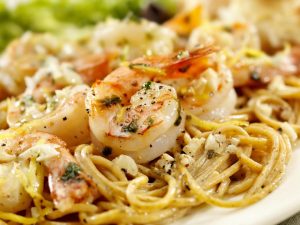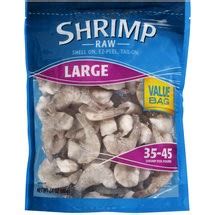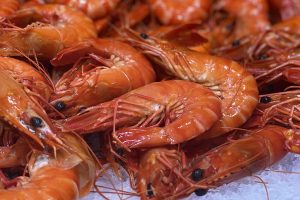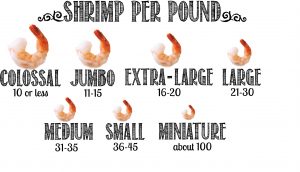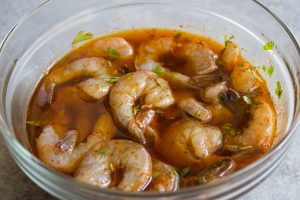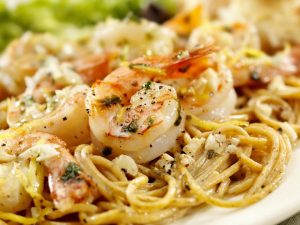If lobsters are the cockroaches of the sea, then shrimp must be sea-going fleas. Shrimp is the most popular seafood in America. In fact, it’s one of the most popular kinds of seafood around the world and through thousands of years of history. There are hundreds of different species of shrimp, ranging in size from tiny brine shrimp (which are not really shrimp) up to big tiger prawns. There is little fossil evidence of how long people have been eating the crustaceans because their shells degrade so fast. But we have many, many dishes that feature these succulent little decapods.
Fresh or Frozen?
Unless you live along a coast, really fresh seafood is rarely available. Even the fresh seafood you see at the grocery store or fishmonger has probably been frozen for its journey to you. Most seafood begins deteriorating immediately after being pulled from the water. Shrimp is no different. That’s why frozen shrimp is better. At least then it has stayed as fresh as when it was caught. Not only that, but frozen shrimp is usually cheaper than the fresh ones, even if they are the same, just thawed. It gives you a lot more flexibility in planning and preparing your meals.
Even frozen, shrimp has a short shelf life and shouldn’t hang out in your freezer for more than a week or so. The only good time to buy really fresh shrimp is if you are cooking them right away. You find this a lot along the coast of the Gulf of Mexico, where shrimp are plentiful are caught nearby.
Peeled and Deveined or Whole
When it comes to prawns, definitely whole creatures, especially still alive, are the way to go. I had the fortune to live with some Chinese guys for a while, and whole prawns were a favorite of theirs. After being steamed, they would just rip the heads off and suck out the insides. It was really good.
But when it comes to smaller shrimp, for me it depends on the size. If I’m buying little cocktail shrimp (71-90), it is much easier to buy them shelled, peeled, deveined and cooked. Then I can just throw them in at the end of cooking just to heat them up. But for larger shrimp, it is better to buy them raw in the shell. You will get a much better flavor and texture. Frozen shrimp are usually headless, so you won’t have to worry about that. But you will have to thaw, peel and devein them before cooking.
What Do Those Numbers Mean?
As I just noted, a number is used as part of the description of the shrimp. The number, 71-90 in this case, is a description of the size, meaning how many shrimp are in one pound weight. So, 71-90 means a one-pound bag should contain about 71 to 90 shrimp, meaning they are very small. A low number, like 16-21 means the shrimp are big, such as the type one would use for a classic shrimp cocktail or a cold buffet.
This is much more accurate than the terms small, medium, large, extra-large, jumbo, and colossal, which have no standard anywhere.
What Size Should I Get?
For most purposes, somewhere around 25 shrimp per pound is about the size we would use for most shrimp dishes, more than bite-size but not unwieldy large, about two bites worth.
Buy the right shrimp for the dish you plan to make. For grilling or individual shrimp, choose larger shrimp, like U-15, which means fewer than 15 shrimp per pound, very large.
Plan on about a half-pound per person, so if you’re having a few people, four to five pounds would be needed for the entrée. Shrimp can be expensive, but it can be very impressive at the dinner table.
First Step: Defrost the Shrimp
There are two safe ways to thaw out frozen shrimp and neither involves even a little heat. The best way is to move the package of shrimp from the freezer to the refrigerator at least a day before. You want to allow about 24 hours per pound.
The second method is to empty the shrimp package into a colander and place it into a clean sink. Put the colander under COLD running water. Never use warm or even lukewarm water. You want to keep the shrimp cold. From time to time, dip a clean hand into the shrimp and stir them around a bit so they all get hit with the water.
Second Step: Peel and Clean Shrimp
If possible, you should cook the shrimp with the shell on. But some dishes would be awkward to eat with the shells on, so you will have to peel them. In either case, you should remove the “vein.”
I like to clean shrimp under running cold water, sending all the mess down the disposal. But then I don’t usually accumulate enough shells to make stock. Start by pulling off the legs. The shell should slip off easily now.
Either peeled or not, shrimp have a dark “vein” running down the back. This is not a blood vein, but an intestine carrying waste to the animal’s anus. Ingesting this will not kill you, but it will make the shrimp taste gritty and unpleasant. So, after you thaw but before you cook, you should remove it. Even if you don’t peel the shrimp, you should remove it by using a sharp knife to cut through the top of the shell and into the flesh, making a long slit from head to near the tail. Use the tip of the knife to remove the thread-like intestine and rinse it out of the animal’s body. If you peeled them, you don’t have to cut through the shell, just the top of the shrimp. They are now ready to be cooked.
What About All Those Shells?
Whenever possible, you should cook the shrimp in the shell. It adds flavor and protects the shrimp from overcooking. But if you do remove the shells, save them to make a seafood broth or stock. Just put them in a freezer bag in the freezer until you’re ready to make the stock. It is a great start to a soup.
Will You Marinate the Shrimp?
There are so many ways to cook shrimp. Many of those will require marinating the shrimp. How long you marinate the shrimp depends on the type of marinade. If the marinade is acidic, containing fruit juice, vinegar or wine, the shrimp should only be in the marinade for less than 30 minutes. In most cases, about ten minutes should be enough to impart the flavor from the marinade into the delicate shrimp. You have to be careful because the acid will actually start cooking the shrimp and make them mushy.
An acidic marinade should be used sparingly. A better choice is a non-acid marinade made with oil, herbs and spices. Shrimp can spend an hour or a little more in that kind of marinade. In either case, put the shrimp and marinate in the refrigerator while it soaks.
Whatever the Method, Shrimp Cook Fast
Just a few minutes on the heat and the shrimp will begin turning pinkish and curling into a C shape. This is true no matter the size of the shrimp. When the flesh is fully opaque and white with pink-orange highlights it should be done. If the shrimp are skewered, the shrimp will change color without curling up very much. This is one case where a meat thermometer is not really necessary. But if you do use one, about 120℉ is usually about right, although that is below the USDA recommendation of at least 140℉. It is rare that anyone gets sick from eating undercooked shrimp.
Now, Which Method Should I Use?
Frying is always quick and easy, especially if you have a nice sauce. Sauté the shrimp in olive oil, add minced garlic, red pepper flakes, some herbs and tomato sauce to make a quick main dish that goes with pasta or rice and some vegetables.
Deep Frying is popular at restaurants but sometimes messy and hard to do at home. There is a secret that Chinese American restaurants have been using for years. First, the thoroughly washed shrimp are marinated in egg whites, tapioca starch and baking soda. Researchers have found that washing the shrimp in more alkaline water makes them crunchier. Baking soda lowers the acidity around the shrimp, holding in more moisture. Then the shrimp are dipped in a batter of flour, cornmeal, salt, pepper, milk, butter and a few drops of hot sauce. Fry them in 350℉ oil for two to three minutes. Fry in batches so the shrimp don’t stick together.
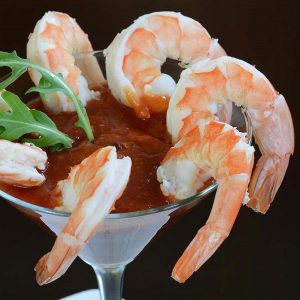
Boiling is popular, especially with other seafood in a potboiler. Add your other seafood in order of how long it needs to cook. Heavy, oily fish go on the bottom, next go the bivalve shellfish, lighter fish, and then crustaceans like shrimp and lobster. Cook it in a flavorful water mixture with lots of spices.
Poaching is a variation on boiling and is good when cooking smaller shrimp for a salad or large shrimp for a traditional Shrimp Cocktail. Bring a pot of water to a rolling boil then add the shrimp. When the water returns to a boil, the shrimp are done and should be removed immediately to an ice bath. Serve with a cocktail sauce made with ketchup and horseradish.
Grilling is popular in the summer. Choose larger shrimp and leave the shells on but devein them. This is a good time to marinade. Brining will also enhance the flavor of the shrimp. As always, they cook quickly, about two minutes on each side.
Baking can produce some really great dishes, like Shrimp Scampi, which is excellent with pasta. Casseroles are another good choice for baked shrimp.
I enjoy Stir-frying shrimp. Start with a hot wok and a few tablespoons of vegetable oil, I prefer soybean oil. The quick cooking time makes shrimp very appropriate for this cooking method. I add onions, garlic, and a touch of toasted sesame oil. Then the heavier vegetables, like peas and water chestnuts, go in, followed by the broccoli. Finally, the shrimp goes in and gets cooked in just a few minutes. I like to add a bit of hoisin and oyster sauce and mix it in just before the dish is done and ready for plating over a bed of rice.
One Final Tip
Many professionals like the consistent quality of the shrimp that leaves the kitchen. They want the decapods looking perfect with a tender, firm, not rubbery, texture. This is achieved with the help of baking soda. This is especially useful if you are breading or battering your fish before frying. Regardless of the cooking method, soaking the shrimp in baking soda water will add a firmer texture to the meat.
